Space Shuttle Launch Complex 39-B Construction Photos
Page 11
Myself and Stuff, PGHM Bridge Beam, Skinner Brothers (Original Scan)
Top left: Myself on the left SRB Access Platform, up next to the RCS Room on top of the RSS. The view from up in this area is really nice. Bottom right: myself again, on the Pad Slope, with the Payload Canister behind me. Top right: Dave Skinner as the PGHM Bridge Beam was worked into position inside the PCR. Bottom left: Steve Skinner (Dave's brother) on the pad deck.
Additional commentary below the image.
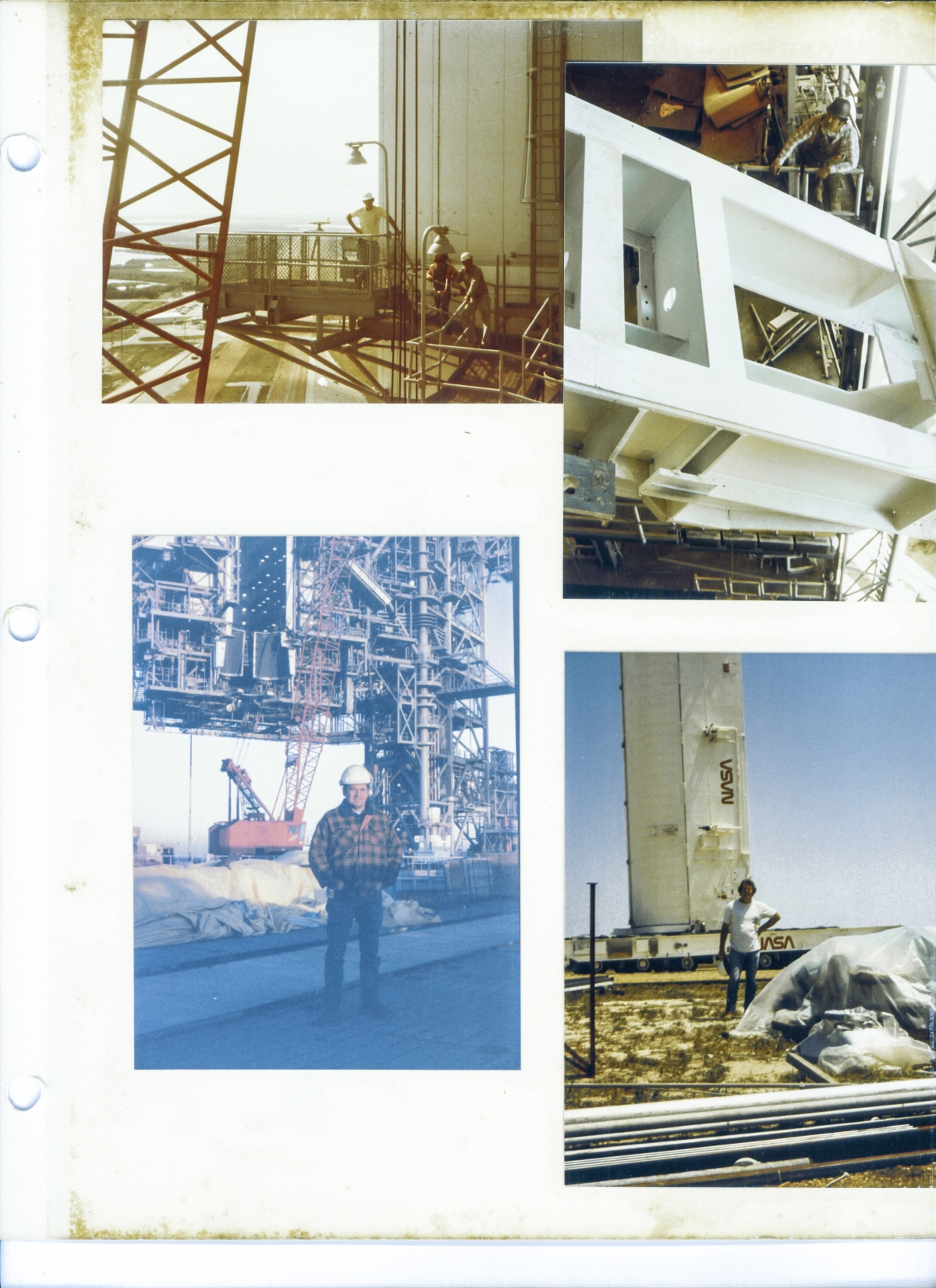
Top Left: (Reduced)
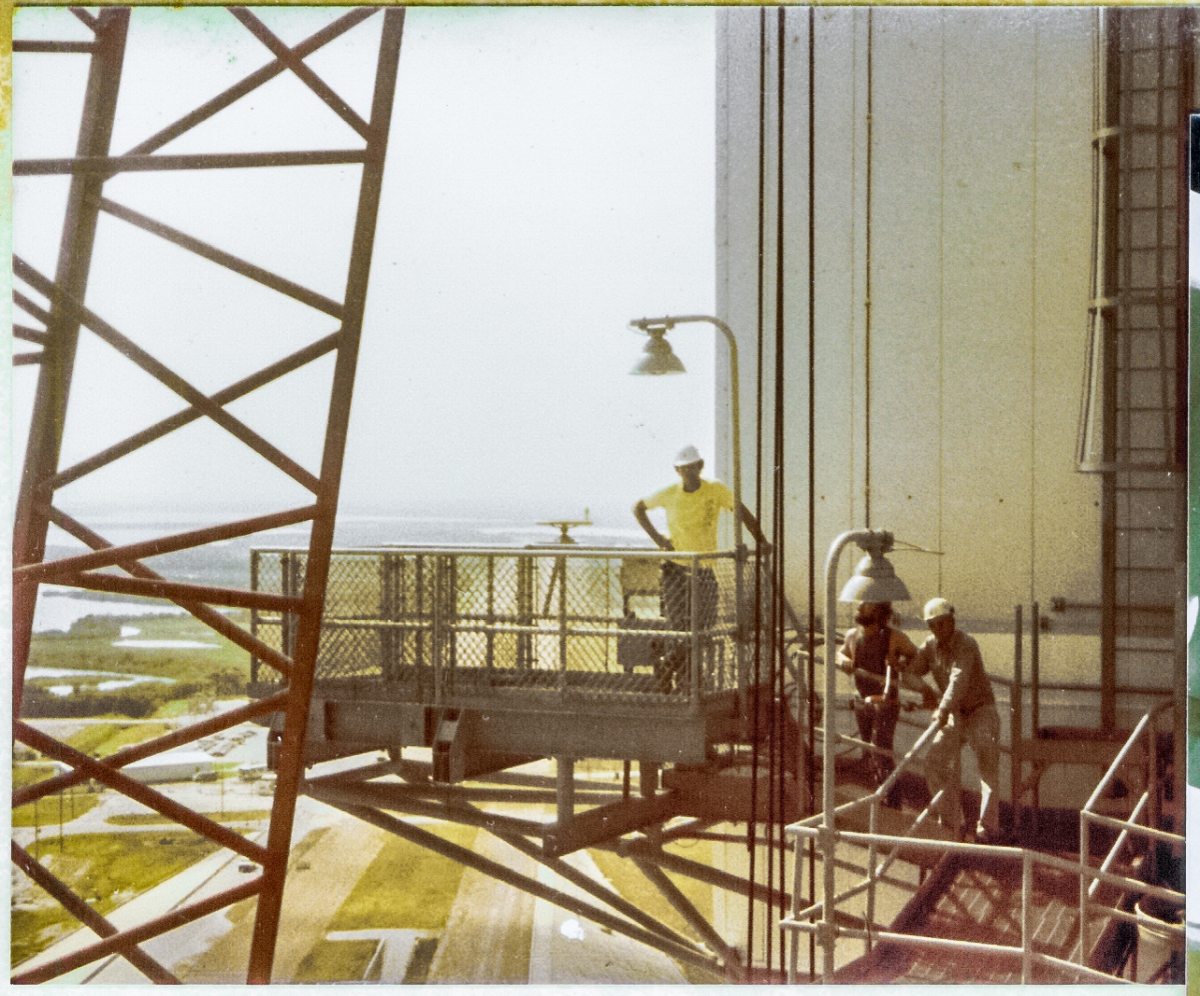
I'm pretty sure this shot was taken by Jack Petty, but I cannot guarantee that. That's me, far left, in the yellow shirt, standing on the left SRB Access Platform. The boom on the Manitowoc is standing up pretty straight, and the location of the 4-part line going down between me and Tommy Northcutt (yet another Good Man), gives me to believe that this photo was taken during the OMBUU lift, and would have better been included with that grouping of images. So ok. So maybe we've got a bit of an idea as to what we were doing at the time.
The guy on the far right is Carlton D. Taylor, who was just an amazing person, in more ways than I'll ever be able to categorize in these essays, and I'm probably never going to get a chance to tell this story anywhere else, so I'm going to tell it right now, even though it has nothing to do with any of the images on this page.
Myself, and Jack Petty, along with Carlton Taylor and Mason Baily went to lunch one day over at the cafeteria that's near the VAB, and while we were there, Carlton realized he'd forgotten, back in his office, inside the pad perimeter fence, the weird Pad-B access badge that they had recently instituted for some damn reason or other, and was going to have to figure out how to get past the guard at the entrance to the pad without causing himself trouble after having left a security document behind, uncontrolled by himself personally, and whatever else that some damn bureaucrat somewhere might think to pin him with by way of an infraction that could cause real trouble, once it was entered into the system.
So ok, now what do we do?
Well... first, you must understand what that Pad B access badge looked like, and what it looked like was stupidity incarnate, and we never did figure out what got into them to propose such a thing, but the badge itself was just a lettuce-green background with the word PAD and a large letter B, underneath it, and absolutely nothing else on the whole badge, anywhere. Just that green background and Pad B in big black blocky letters, and that's it. No name, no employer, no identification for any individual human of any kind on it. And yeah, like I said earlier, it was stupid, but everybody got issued one, and it was also required, so we had to do something about it.
Hmmm.... lettuce green? Hmm hmm hmm.
And we're sitting there in the cafeteria, with food on the plates, and somebody had a hamburger, and by god... lettuce!
And Carlton hatches his crack-brain plan while me and Jack and Mason cackle with laughter.
Carlton takes one of our badges, and sets it on a big leaf of lettuce (No. Really. He really did.) and then he very carefully tears the lettuce into a surprisingly good simulacrum of a badge, and takes it with him when we depart the cafeteria.
And off to the pad we go!
There's four of us in the car, two in front, two in back, and as we approach the guard at the pad perimeter fence over on the right-hand side standing in front of the guard shack, we all take our "badges" (lettuce included), and all kind of hold 'em up in a bunch more or less overlapping each other on the right-hand side by the windshield all casual-like, as we slow to a crawl (but never quite come to a full stop), past the bored guard, who waves us through, but who then immediately reconsiders, and hollers for us to stop, points at Carlton in the back seat on the right-hand side (I was on the left side in back, and had a perfect view of the whole subterfuge from start to finish), and asks to see his badge once again, but while that was going on, Mason surreptitiously palmed his real badge to Carlton who had ditched his piece of lettuce, and who then presented Mason's badge to the guard with an air of utter and complete innocence, and by god the guard waved us right on in!
We never did stop laughing about it.
True story.
Ok, back to the picture.
I'm standing on the left SRB access platform, which would put me just about straight directly above the OMBUU, and I guess I'd been prowling around on the tower looking for photography angles on the lift. Whether this shot was taken before or after the bottom right shot on page 3, is not something I recall at this time. I've got a pretty good memory, but let's face it, this all happened well over thirty years ago, and there's only so much you can dredge back up across a gulf of time that wide.
The SRB access platforms were extensible, and comprised a platform within a platform, and the interior platform rolled out and in, forwards and backwards, firmly restrained by a set of roller-bearings as it did so to prevent it from jumping up or down, and it was actuated via turning the classic-looking crank handle you can see there, just to the left of my right elbow in the photograph. The extensible part of the platform is retracted in this view, but when the RSS was rotated around to the mate position with a Shuttle Stack on the pad, it would have been extended as necessary to provide access to the very top part of the left SRB, which would have been blocking the view of everything in the distant background (which would have been the ocean with the RSS swung around, mated to the bird) on the left side of things as seen from this point of view, looking from what appears to be the 220' level on the FSS, and the orangish-brown body of the External Tank would have been blocking everything else, from there over to the edge of the RCS Room.
You'd climb around on that fucking RSS for literal years and yet it would still be disorienting when something that titanic in size and mass had moved a surprising distance across solid ground into a position and orientation that differed significantly from your usual expectations, developed over time when it was in the de-mate position as it is in this photograph.
Directly below the support framing for the platform I'm standing on, 200 some-odd vertical feet down, you can see the twin tracks of the crawlerway on the pad slope, which then extend into the far distance through the chain-link that's attached to the SRB access platform handrails.
Immediately to the left of the very end of the platform support framing, through the latticework of the crane boom, you can see the white rectangle of the Ops Building. Past the Ops Building, a couple of rows of cars are visible in the parking lot. That parking lot is where the Centaur porch was sitting when I took the shot of Kai standing on it, that you can see back on page 4. It's kind of nice to be able to maintain a proper sense of where everything is, sometimes.
The exact location of the Centaur porch would have been past the cars, and to the right just a little bit, blocked from view by the platform framing.
Go back to that picture, and then take a look at the RSS in the distance behind Kai and try to integrate that with what you're seeing in this image. From Kai's point of view, the RSS doesn't really look like much directly above his head, and you have to stop and make a deliberate effort to locate the white rectangle of the RCS Room on top of the RSS, partially blocking the view of the FSS behind it, and then more or less imagine (it's visible, but just barely, and you have to zoom way the hell in on that full-size image), that SRB access platform on the far side of the RCS Room, with me standing on top of it. Of course from Kai's point of view, the RSS is closing in on being a full half mile away, and most things a half mile away aren't going to look like much, right?
That said, Kai knows exactly how big the RSS is, because, on 11 February 1984, when he was a small child, they opened the pad deck up to those of us who worked on the pad along with our families, and I held him in my arms, above the heads of the crowd that surrounded us, and he watched with his own eyes as the first orbiter to land back at KSC, where it had originally departed from, took its heading alignment circle against a clear blue morning sky, and literally traced an arc through the main structural framing members of the RSS, almost directly above his head, on its way to a smooth and safe touchdown at the SLF. Sometimes the light in a little kid's eyes has the power to completely overwhelm you, and when that happens, it stays in your heart forever.
Top Right: (Full-size)
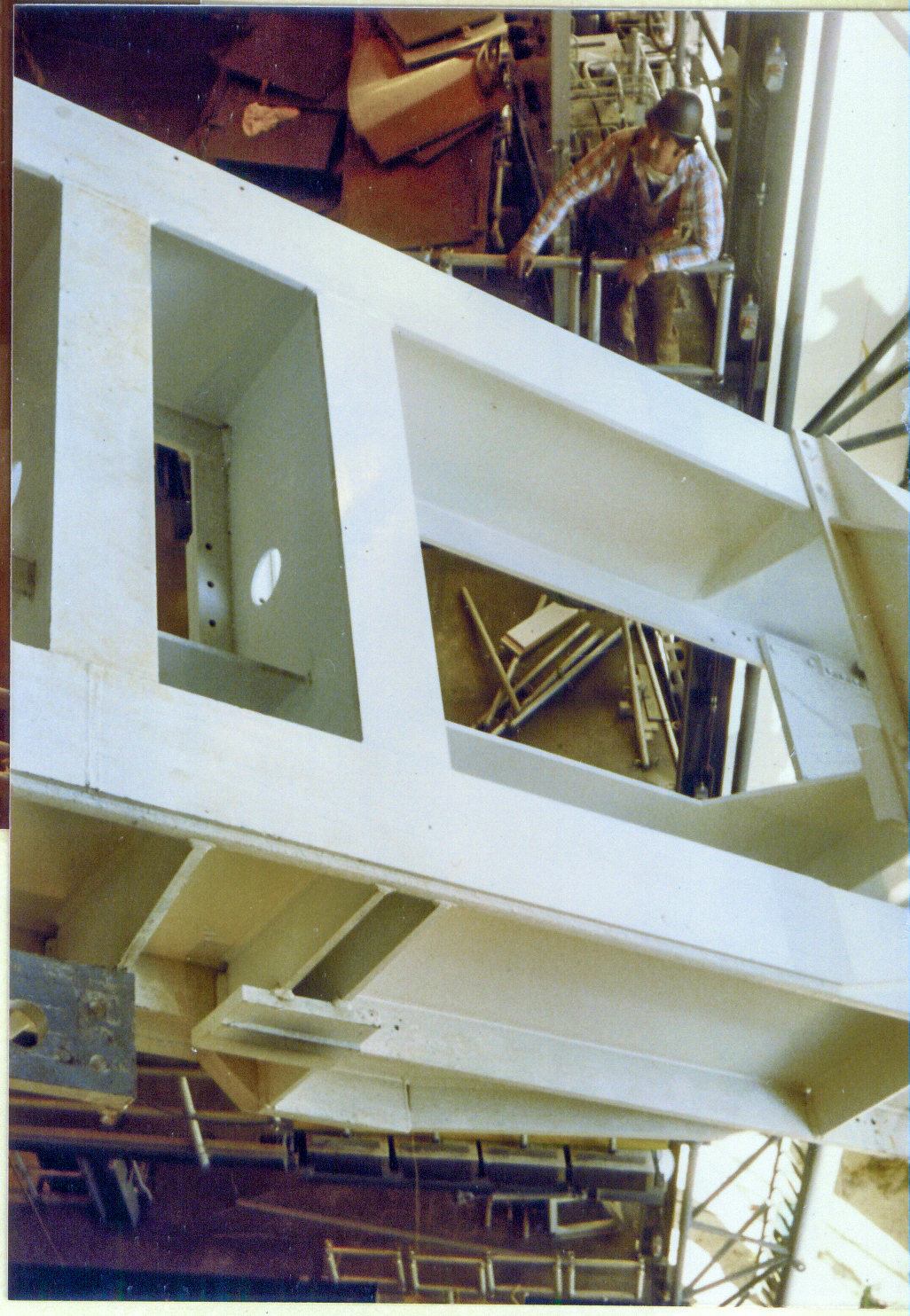
Payload Ground Handling Mechanism Bridge Beam installation. The bridge beam clear-spanned the width of the PCR (it's a bridge, after all), and rolled forward (toward the PCR Doors) and back (away from the PCR Doors) on a set of rails which would do just fine for holding up a fully-loaded diesel locomotive, that were themselves supported by some Serious Iron way up in the top of the PCR. I don't even know where to start with that goddamned PGHM. Remember on the previous page where I said that individual items all by themselves could be "deeply contrapted, complex, and confusing to understand?" Well, the PGHM (invariably pronounced by one and all as "piggum") is superlatively qualified for such a categorization. Ludicrously so, in fact.
And the PGHM, being the monstrosity that it was, required equally-monstrous support, and it's just a small part of that monstrous support which you see here, all slick clean white, sitting at a nightmare cocked-ass angle, getting threaded into the deepest innards of the PCR by an impossible combination of overwhelming brute force, brain-surgeon delicacy, and black-magic fuckery, as practiced by the union ironworkers of Local 808, working for Wade Ivey. Dave Skinner is one of those ironworkers, and there he is, looking on, keeping a close eye on whatever it is that can be seen (and there's a lot that can't be seen) from his perch on the PCR Interior Platforms, level 4, as the PGHM bridge beam goes in.
Payloads are insanely expensive things, oftentimes built one-off, bespoke, with costs running well into the hundreds of millions of dollars, and they're outlandishly delicate and are fitted together with close-tolerances that are very very close indeed, and for those reasons, and others, the stuff they use to work on them must be both rock-solid and forgiving and flexible (but only in very precise and tightly-constrained directions and distances), even if it's something inside of a fifteen-story apartment building slung sixty feet aboveground up into the air, which moves around for god's sake, and the results of all that insane requirement for rock-solid and precise can be seen in the extraordinary sturdiness in the construction of our PGHM bridge beam. Hang the full weight of the whole goddamned PGHM on this bridge beam which moves on rails inside of the RSS, and then hang the full weight of the whole goddamned payload stack on the PGHM, and then go roll your bridge beam back and forth as you work on a multi-billion dollar Space Shuttle, which is connected to the ground and supported completely separately by the MLP, and which nowhere actually touches or comes into true physical contact with the RSS or anything inside or outside of the RSS, and which also moves and flexes in the wind for god's sake, and then also moves and flexes as the weight of the payload is transferred from the PGHM to the orbiter, and this bridge beam will not deflect by so much as any amount that you can see, even if you're looking right at it, which is good, because if it did you just might break your Space Shuttle, or payload, or even both of them.
This fucker needs to be stout, and by god this fucker is stout.
Which made for some pretty ticklish clearances when it came to getting the motherfucker, which had been prefabricated elsewhere and shipped cross-state to B Pad, up into the air and properly inside of an already-built payload changeout room up on the RSS.
There will be more on this subject, later, but for now, consider yourself properly introduced to the PGHM bridge beam.
Bottom Left: (Full-size)
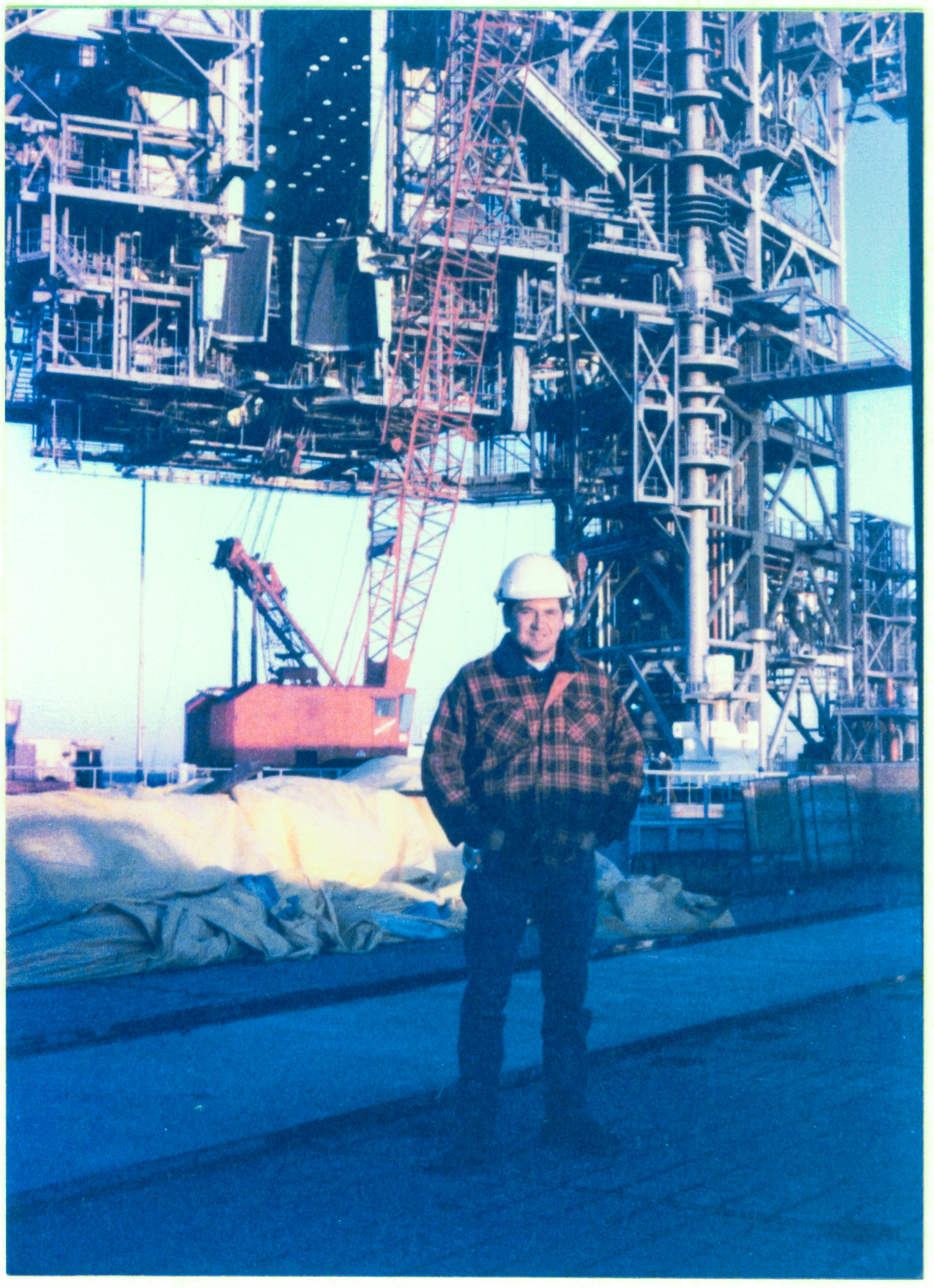
Steve Skinner, another Good Man, up on the pad deck, dressed for the chill of winter (and yes it occasionally gets cold in Florida, although not very often, thankfully). This photo was taken shortly before actual lifting operations commenced, the morning of the PHGM bridge beam lift. Zoom in on the image and look closely at Steve's left elbow, and in the distance behind it, across the flame trench on the other side of the pad deck, a couple of gentlemen are walking side by side, and behind, to the right and above them, beneath and a hair left of the white covering on top of the MLP Mount Pedestal, is the white complexity of one end of the PGHM bridge beam, laying on the pad deck, waiting to be lifted. An even smaller bit of the bridge beam, so small as to be near-invisible, can also be seen, peeking out from behind the fabric of his coat, just above Steve's right elbow.
Behind Steve in the image above these words, on the other side, directly in line with and well above the body of the Manitowoc crane, the pair of clamshell-looking OMS Pod heated purge covers which hung on the support steel at the RSS 135' level in a most disconcerting way, and which eventually nearly killed some people over on Pad A, can be seen immediately below the gloom of the payload changeout room, the bi-fold doors to which are sucked back inwards, in the open position, completely out of view, giving you a look, dimly, very dimly, into the area of the PCR interior platforms, with its host of interior lighting fixtures which looks kind of like a fleet of flying saucers floating around in the deep gloom.
Zoom way the hell on in. Three or even four hundred percent zoom. There is handrail and framing steel detail to be seen, dimly, very dimly, around those flying saucers, if you look closely.
Hopefully I'll get to elaborate more on those goddamned OMS Pod covers, 'cause they're well worth the time it might take to describe the psychosis of the multiply-flawed, and deeply flawed at that, engineering premises upon which they were designed and constructed, and which resulted in their innocent-enough outward appearance you see here. We knew from the beginning that they were going to get somebody one day, and nobody ever trusted the miserable sonofabitches to the slightest degree.
Bottom Right: (Full-size)
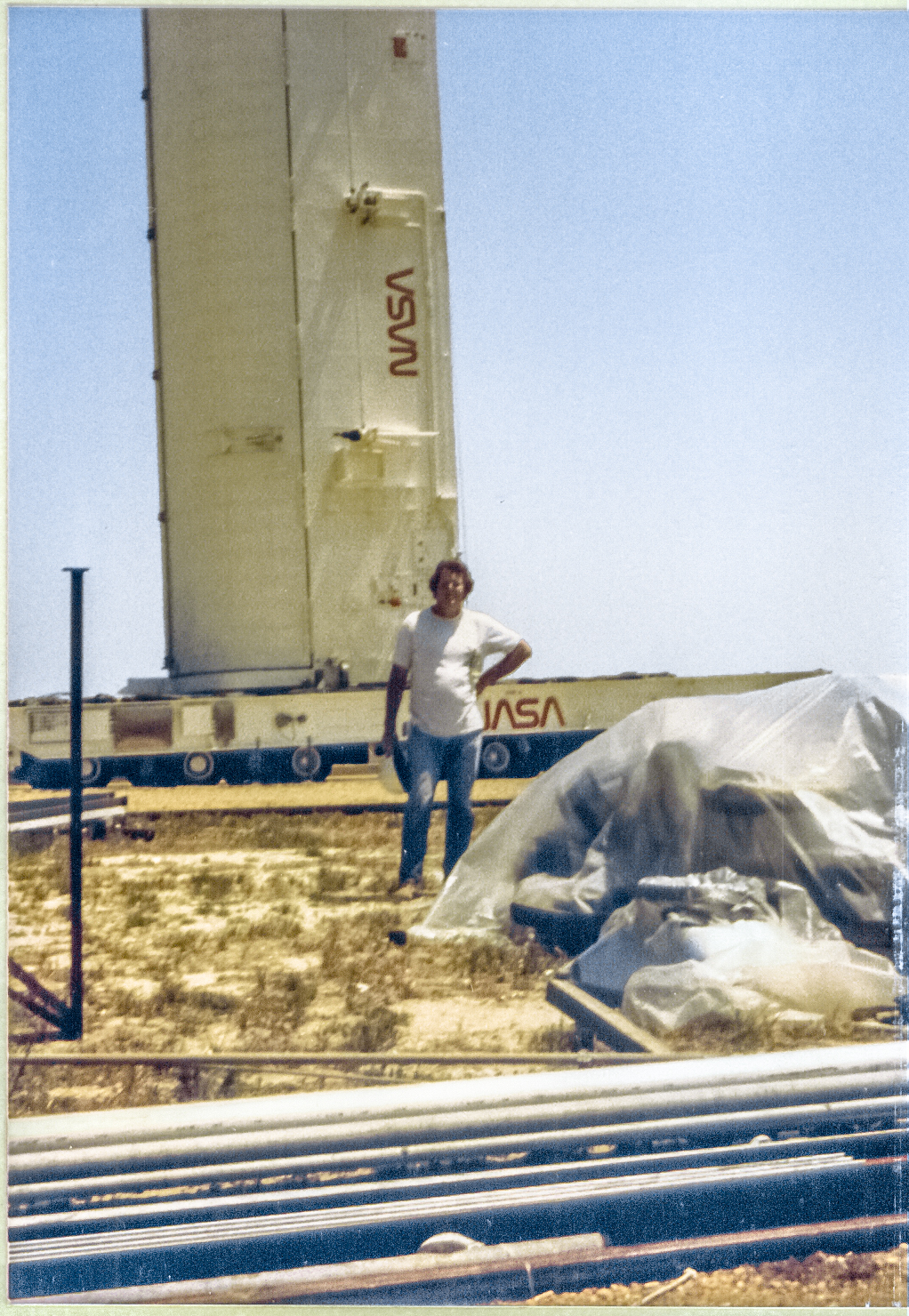
Me in front of the canister, photo by Jack Petty.
Return to 16streets.comACRONYMS LOOK-UP PAGEMaybe try to email me? |